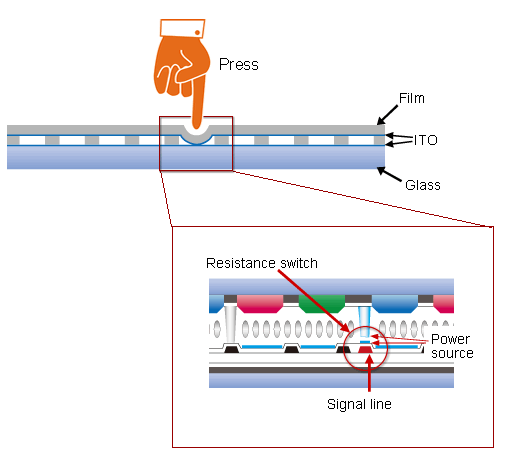Complex requirements like multi-input capability or sensing the writing pressure on the resistance film demand a very fine pattern and a high-precision screen-printing technology. Micro-tec machines are capable of such high-tech requirements.

 On the outside of the screen of smartphones and tablets, there are electrode wires arranged to achieve touch control function. Usually, to cover the wiring line, ink is applied as decoration on the edges. Decorative printing refers to the printing of edge decoration using specialized paste and screen printing. Most of them are black decorations (commonly known as BM), but recently white decorations (commonly known as WM) have also appeared.Edge coloring is not simple. Firstly, the light source must not be exposed from the edges. In order to achieve touch control function, it is necessary to maintain uniform film thickness of the slurry and meet the unified requirements of mass production.This requires high-precision screen printing machines to achieve.
On the outside of the screen of smartphones and tablets, there are electrode wires arranged to achieve touch control function. Usually, to cover the wiring line, ink is applied as decoration on the edges. Decorative printing refers to the printing of edge decoration using specialized paste and screen printing. Most of them are black decorations (commonly known as BM), but recently white decorations (commonly known as WM) have also appeared.Edge coloring is not simple. Firstly, the light source must not be exposed from the edges. In order to achieve touch control function, it is necessary to maintain uniform film thickness of the slurry and meet the unified requirements of mass production.This requires high-precision screen printing machines to achieve.
Application of Screen Printing in Thick Film Heat Exchangers
Thick film heating elements are mainly divided into two types: ceramic heating elements and metal heating elements. It refers to the effect of printing thick film circuits on ceramic or metal substrates to achieve rapid heating.
Metal heating elements are mainly made of stainless steel heating elements, while others include titanium alloy heating tubes, nickel based alloy heating tubes, etc. Stainless steel heating elements have advantages such as simple structure, good corrosion resistance, good heat dissipation performance, and stable technical performance. However, they also have disadvantages such as poor high-temperature resistance, thermal conductivity, and safety.
Ceramic heating element is a high-tech heating element made by co firing a series of special processes, using high thermal conductivity alumina as the substrate and heat-resistant and insoluble metal as the inner electrode to form a heating circuit.
It is divided into MCH ceramic heating element and PTC ceramic heating element according to different purposes.
MCH ceramic heating elements are mostly curved, circular or filamentous, mainly used in electronic atomizers, intelligent toilets, instant dual mode water heaters, electric water heaters, hair straighteners, curlers, automotive exhaust oxidation sensors, industrial equipment heating devices, ultrasonic heating elements, mold heating insulation devices, medical device heaters, and small heating appliances.
PTC ceramic heaters are mostly in sheet shape, and are mainly used in air conditioners, hot air curtains, dehumidifiers, dryers, Clothes dryer, Fan heater, Yuba, automobiles and other equipment that need warm air.
The most widely used alloy wire heating elements and PTC heating elements and their components in ceramic heating elements are gradually being replaced by HTCC ceramic heating elements.

The Application of Screen Printing on Sensors
The application of screen printing on sensors mainly involves printing electrode layers and insulation layers. Due to its flexible design, simple structure, good consistency, low cost, and ease of large-scale production, it can be printed into single electrode systems, double electrode systems, three electrode systems, and even more complex multi electrode systems as needed. In recent years, the application range of screen printed electrodes has gradually expanded, and they have wide applications in electrochemical biosensors, including enzyme sensors, immune sensors, gene sensors, and other fields.

Thick film printing technology is widely used in the production of electronic components. If you have production demand, please contact us as soon as possible.
Printing samples








 On the outside of the screen of smartphones and tablets, there are electrode wires arranged to achieve touch control function. Usually, to cover the wiring line, ink is applied as decoration on the edges. Decorative printing refers to the printing of edge decoration using specialized paste and screen printing. Most of them are black decorations (commonly known as BM), but recently white decorations (commonly known as WM) have also appeared.
On the outside of the screen of smartphones and tablets, there are electrode wires arranged to achieve touch control function. Usually, to cover the wiring line, ink is applied as decoration on the edges. Decorative printing refers to the printing of edge decoration using specialized paste and screen printing. Most of them are black decorations (commonly known as BM), but recently white decorations (commonly known as WM) have also appeared.





